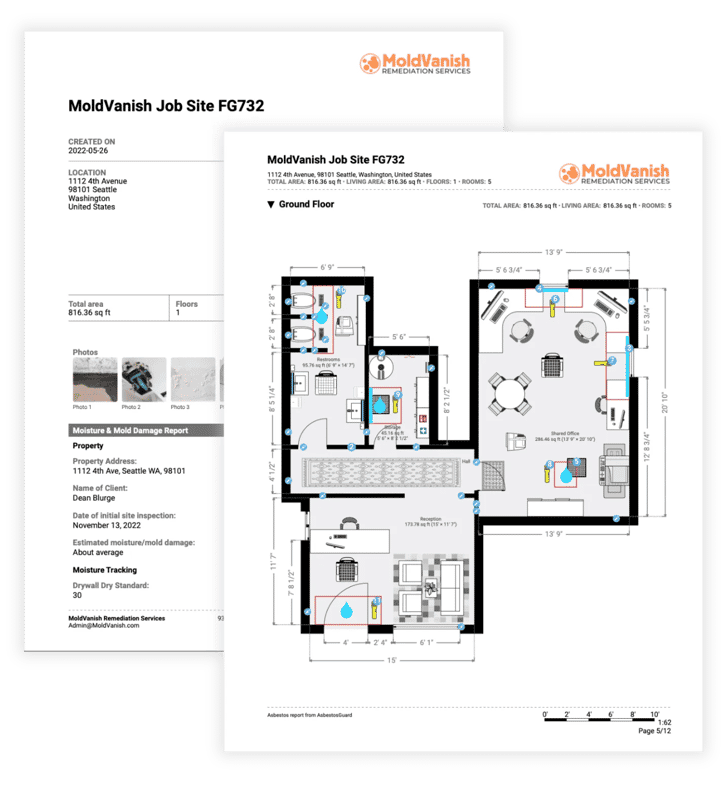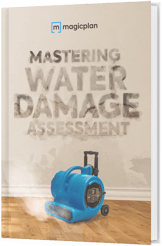Restoration
What to Include in Professional Water Damage Reports

If you are a professional residential contractor, inspector or adjuster, you may be called upon to create residential water damage reports. Thorough, accurate reports serve as written evidence, which is essential for verifying insurance claims and for determining any restoration work that is needed. Each report should cover multiple topics, including the type of water involved, the extent of the damage, and recommended restoration work.
So, let’s walk through the process of developing a report.
First, Determine the Best Way to Create Your Document
Before you begin working on a water damage report, decide how you want to create it. There are two ways to go about this:
• The traditional method involves drafting, printing and mailing a paper document with printed photos attached.
• The newer method involves creating and emailing a digital report with a mobile app that is designed specifically for this purpose.
Once you decide which method to use, you can begin building the contents of your report.
Prepare to Conduct Your Inspection Safely
Prior to starting your water damage inspection, make sure the home is safe to enter. Check for any electrical hazards, fire hazards and gas leaks. You may even need to have the electric and gas services turned off before entering the home.
Be sure to wear sturdy, slip-resistant shoes, rubber gloves and eye protection. And if you suspect mold is present, wear a respirator that filters spores.
Begin Your Report by Inserting Basic Information
Your report should state:- Your name (the person who is writing the report), along with your title and company name
- The date on which you are preparing the report
- Name of the property owner (claimant)
- Details of the property – i.e., location, type of property, age of property
- Probable cause of the water damage (e.g., a natural disaster or rainy weather, air-conditioning unit condensation, a defective water supply line, cracked/leaking household water pipes, broken household appliances, a clogged drain, a septic tank and or sewer backup, an old or faulty water heater, a damaged sprinkler system, water overflow from a toilet, an inoperative sump pump, inefficient roof water drainage, etc.)
Specify the Category of Water Damage
Water damage typically falls into one of three categories:- Category 1: White Water – clear water that is considered clean, sanitary, and safe for human use (such as fresh water from indoor plumbing)
- Category 2: Gray Water – indoor water that has some contaminants (such as water from dishwashers and washing machines), and water that has entered the home from outside (such as rainwater)
- Category 3: Black Water – water that is severely contaminated with dangerous toxins and pathogens (e.g., toilet water, sewage runoff, flood water)
Aside from identifying the level of water damage, a thorough assessment of the affected premises will give you a clearer picture of the extent of damage, and how much the repairs could cost.
Learn more: Understanding Water Damage Categories 2 and 3: Restoration Contractors
Document the Damaged Areas and Contents
Once you have determined the category of water damage, you’ll need to conduct a thorough assessment of the affected premises. This will give you a clearer picture of the impact on the home, as well as the amount of water damage restoration work that will be required. Be sure to include an adequate description for each type of damage you find (where is it, what is it, how bad is it).A water damage inspection typically starts from the uppermost area inside a home and works downward. Areas to be inspected may include:
- Attic
- Bedrooms
- Bathrooms
- Living room
- Family room
- Kitchen
- Dining room
- Laundry area
- Mudroom
- Utility room
- Basement
- Crawlspaces
Depending on the cause of the water damage, you may also need to inspect the outside of the home’s structure, which includes the following:
- Roof
- Eaves/Gutters
- Exterior coverings (e.g., siding)
- Doors and windows
- Crawlspace
Include Moisture Readings
There’s often more to water damage than meets the eye. That’s why moisture readings of hidden areas are a critical part of water damage assessment. So, you’ll want to use a digital moisture meter to test the moisture levels of the home’s ceilings, walls and floors. Then add those readings to your water damage report.
In addition, you can use a digital hygrometer to test indoor humidity levels (i.e., the moisture content of the air). Be sure to add those readings as well.
You may also want to mention the exact tools you used to gather your moisture and humidity readings. Specific information like this can help increase the thoroughness of your report.
Watch this video tutorial on how to accurately assess and document moisture intrusion →
Add Your Recommendations for Remediation and Restoration Measures
Once your water damage inspection documentation is complete, you can add a section that outlines your recommendations for next steps. Try to be as detailed as possible. One way to do that is to create a digital floor plan, and then mark up the plan with work recommendations for each affected area of the home. This is a great way to communicate exactly what needs to be done. In fact, a digital floor plan can be useful for a number of reasons.
Enhance Your Documentation with Detailed Photos
During your inspection, you can take photos easily with a mobile device – either a smartphone or a tablet. You do not need a fancy camera.
Be sure to take photos of:
- all structural damage throughout the home
- all damaged materials and finishes (flooring, paneling, etc.)
- all damaged contents (furniture, décor, electronics, clothing, etc.)
- the cause(s) of the damage
If you are creating your report with a high-quality digital floor plan app, you should be able to attach all of your photos easily and efficiently.

Conclusion
Building a comprehensive, detailed water damage assessment report is necessary for initiating insurance claims and planning restoration work. Be sure to include all critical information, and use handy digital tools to support and speed up the process.
LEARN 3 Strategies for Efficient Estimating of Water Damage Mitigation Projects
Learn Why and How to Maximize Air Movement During Water Damage Cleanup
Or read our guide on How to Manage Category 3 Water Damage Mitigation
Bernd Wolfram
Head of Product

